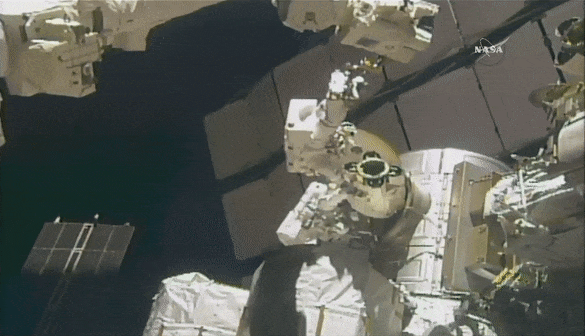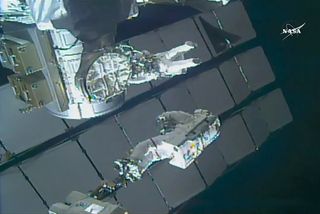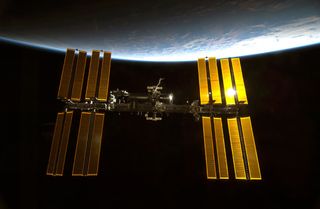Spacewalking Astronauts Breeze Through Robot 'Hand' Work on Space Station

Two astronauts took a spacewalk outside the International Space Station (ISS) today (Feb. 16) to continue ongoing maintenance on the station's robotic arm, Canadarm2.
NASA astronaut Mark Vande Hei and Japanese Aerospace Exploration Agency (JAXA) astronaut Norishige Kanai emerged from the Quest airlock at 7 a.m. EST (1200 GMT) and spent 5 hours and 57 minutes working to relocate a pair of Canadarm2's robotic "hands," called latching end effectors (LEEs), which were replaced with new units during a pair of spacewalks in October and January.
Those LEEs are used to grapple incoming spacecraft, and they allow the 58-foot-long (17.6 meters) Canadarm2 to move around the outside of the station almost like a giant, robotic inchworm. Crewmembers inside the ISS can also manually operate the Canadarm2 and LEEs to assist their crewmates during spacewalks, as NASA astronaut Joe Acaba did today. [In Photos: The Space Station Spacewalks of Expedition 54]

With Vande Hei standing on a portable foot restraint at one end of Canadarm2, Acaba used the robot arm to give Vande Hei a lift as he moved the 440-lb. (200 kilograms) LEEs around the station. While that's a lot of weight for a person to lift on Earth, the equipment doesn't weigh anything in microgravity.
"In space, you can just grab it with one hand and take selfies with the other," NASA TV commentator Rob Navias said during a live broadcast of the spacewalk. However, each LEE is still about the size of a mini-fridge, so riding on Canadarm2 certainly beats lugging the LEEs around while climbing across the structures of the ISS.

The first LEE that the spacewalkers relocated today was the former LEE-A, which Vande Hei and NASA astronaut Randy Bresnik had swapped out for a new unit during a spacewalk on Oct. 5. During that spacewalk, the degraded LEE was temporarily stored on the station's Mobile Base System (MBS), a portable platform that serves as a base for Canadarm2.
Today, Vande Hei and Kanai removed the LEE from the MBS and brought the robotic hand back inside the ISS through the Quest airlock. The LEE will eventually return to Earth in a SpaceX Dragon cargo capsule. The Canadian Space Agency will then refurbish the LEE and launch it back to the ISS, where it will serve as a spare unit in case Canadarm2's current LEEs encounter any problems.
Get the Space.com Newsletter
Breaking space news, the latest updates on rocket launches, skywatching events and more!
The spacewalkers then moved on to LEE-B, which Vande Hei and NASA astronaut Scott Tingle replaced during another spacewalk, on Jan. 23. Kanai and Vande Hei moved that LEE from a temporary storage space outside the Quest airlock to a long-term storage spot on the MSB. This LEE "showed signs of degradation, but still could be functional," so it will stay at the ISS as a spare unit, Navias said.

Kanai and Vande Hei completed both of these primary tasks in under 3 hours, or less than half the planned duration of today's spacewalk. This left plenty of time for "get-ahead" tasks, which included the lubrication of the latches and central ball screw inside the new LEE-B.
Today's spacewalk officially ended at 12:57 p.m. EST (1757 GMT), when the spacewalkers switched their spacesuits off from battery power inside the Quest airlock. The spacewalking duo had more than 30 minutes left to spare when they completed all their primary tasks and several of the get-ahead tasks.
Vande Hei has now completed his fourth spacewalk and has accrued a total of 20 hours and 45 minutes of spacewalking time. Kanai, a first-time spacewalker, has now accumulated 5 hours and 57 minutes.
This was the third spacewalk this year and the 207th spacewalk in the station's history.
Email Hanneke Weitering at hweitering@space.com or follow her @hannekescience. Follow us @Spacedotcom, Facebook and Google+. Original article on Space.com.
Join our Space Forums to keep talking space on the latest missions, night sky and more! And if you have a news tip, correction or comment, let us know at: community@space.com.

Hanneke Weitering is a multimedia journalist in the Pacific Northwest reporting on the future of aviation at FutureFlight.aero and Aviation International News and was previously the Editor for Spaceflight and Astronomy news here at Space.com. As an editor with over 10 years of experience in science journalism she has previously written for Scholastic Classroom Magazines, MedPage Today and The Joint Institute for Computational Sciences at Oak Ridge National Laboratory. After studying physics at the University of Tennessee in her hometown of Knoxville, she earned her graduate degree in Science, Health and Environmental Reporting (SHERP) from New York University. Hanneke joined the Space.com team in 2016 as a staff writer and producer, covering topics including spaceflight and astronomy. She currently lives in Seattle, home of the Space Needle, with her cat and two snakes. In her spare time, Hanneke enjoys exploring the Rocky Mountains, basking in nature and looking for dark skies to gaze at the cosmos.
